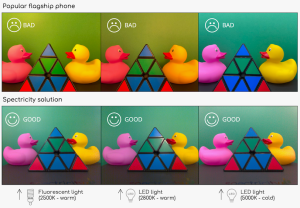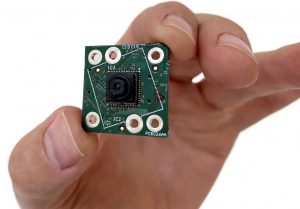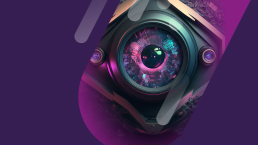Spectricity Announces Collaboration with Qualcomm to Bring Spectral Imaging to Next Generation Smartphones, Unlocking Accurate Color and Seeing Beyond What’s Visible.
Both companies agree on the development of a native reference design for use with premium Snapdragon® mobile platforms.
Barcelona, Spain, February 26, 2024 — Spectricity announces a collaboration with Qualcomm Technologies, Inc. for Spectricity to develop native reference design support for use with premium Snapdragon® mobile platforms and Spectricity’s spectral image sensor products.
The collaboration will allow for a faster, more efficient implementation for OEMs to integrate spectral imaging in their mobile devices. This in turn can bring significant improvements for camera AWB (automatic white balancing) performance, resulting in more accurate and more pleasing photography, including portraits with accurate skin tone. New applications including e-commerce cosmetics, color picking, as well as skin health analysis are also enabled.
“Qualcomm Technologies is committed to delivering revolutionary image capabilities in our premium mobile platforms to consumers”, said Judd Heape, VP of Product Management at Qualcomm Technologies, Inc. “By collaborating with Spectricity, we can enable these cutting-edge technologies to offer advanced spectral image sensor integrations for extraordinary camera experiences.”
Glenn Vandevoorde, CEO of Spectricity: “We are committed to bringing spectral imaging to smartphones. Our collaboration with Qualcomm Technologies., is a critical step in enabling OEMs to build better cameras for their mobile products, and new, differentiated applications that will improve our daily life, including health. We’re excited to enable this for use on the world's most popular mobile SoC platform.”
About spectral imaging
Spectricity’s unique and patented CMOS multispectral imaging technology extends the paradigm of RGB 3-color filters to 16 or more filters. It allows the measurement of spectral signatures of light for each pixel, to extract properties about the light source or objects in the scene. This in turn enables better white point measurement, or extraction of skin biomarkers such as blood volume of melanin.
Spectricity’s S1 is the world's first truly-miniature spectral camera module for mobile devices, leveraging Spectricity’s CMOS high-volume supply chain, as well as its spectral imaging software IP. The technology and the products powered by it are the fruit of more than 15 years of research and development.
Availability
An evaluation and software development kit featuring compatibility with Spectricity’s S1 spectral image sensor is expected to be available from Spectricity this year.
Snapdragon is a trademark or registered trademark of Qualcomm Incorporated. Snapdragon is a product of Qualcomm Technologies, Inc. and/or its subsidiaries.
About Spectricity
Spectricity, a Belgium-based fabless company founded in 2018, stands at the forefront of spectral sensing solutions crafted with advanced CMOS technologies. Fueled by venture capital and an exclusively-licensed patent portfolio from imec, a global leader in nano-electronics and digital technologies, Spectricity pioneers innovations designed for high-volume production and integration into consumer and mobile devices.
With a commitment to sensing beyond the visible, Spectricity's vision is to enhance life through unparalleled spectral information, anytime, anywhere. Its mission revolves around enabling the widespread adoption of spectral imaging by seamlessly integrating miniaturized sensing solutions. Spectricity's disruptive innovations, protected by a comprehensive collection of patents, strive for accessibility and affordability, opening doors to new possibilities in various consumer markets.
Beyond Pixels: Transformative Journey of AWB
Automatic White Balance (AWB) technology, a seemingly subtle yet pivotal aspect of imaging devices, has undergone a century-long evolution. From its roots in Max Planck's quantum theory to recent innovations by companies like Spectricity, AWB has played a crucial role in shaping how we capture and perceive the world through cameras. Beyond its impact on photography, advanced AWB's advancements hold promise for a spectrum of applications, from enhancing medical diagnostics to contributing to the field of artificial intelligence.
Understanding AWB
At its core, AWB operates as the intelligent guide for color temperature adjustments in images, ensuring that whites remain truly white, regardless of ambient lighting conditions. Max Planck, a notable figure in quantum physics and a Nobel laureate in Physics in 1918, played a pivotal role in laying the theoretical groundwork for AWB. Commissioned by electricity providers in the late 1800s to enhance the brilliance of light bulbs with minimal energy consumption, Planck developed a model linking the color of light to the temperature of a theoretical black body. This model detailed the progression of emitted light, transitioning from warm hues around 1500° Kelvin to pristine white light at approximately 5000° Kelvin and culminating in cooler tones above 15000° Kelvin.
Planck's theoretical model found a digital translation with the establishment of the International Commission on Illumination (CIE) in 1931. The CIE Color Space, a milestone in color science, comprehensively mapped all colors perceptible to the human eye. Within this expansive color space, the Planckian Locus emerged—a guiding trajectory based on temperature. This locus paved the way for the color temperature sliders ubiquitous in modern imaging software, allowing nuanced adjustments aligning with the temperature-based color transitions observed in Planck's original model.
The integration of Planck's theories into digital photography marked a transformative journey. From theoretical concepts rooted in quantum physics, AWB evolved into a fundamental tool in a photographer's kit. The transition from film to digital pixels prompted recalibration of AWB algorithms to meet the challenges and opportunities of the digital canvas. This historical odyssey—from Planck's theoretical groundwork to the present—signifies not just the evolution of a tool but also illustrates the symbiotic relationship between scientific ingenuity and technological progress. AWB has become a technological language, shaping the narrative of our visual experiences and standing as a testament to the persistent pursuit of accurate color representation in the ever-evolving realm of photography.
Challenges with Traditional AWB
AWB has undoubtedly been a revolutionary force in photography, ensuring that images present accurate color tones. However, the journey hasn't been without its hurdles. One of the primary challenges lies in the variability of lighting conditions encountered in real-world scenarios. Traditional AWB algorithms, while adept at adjusting color temperature, can falter when faced with complex lighting situations, leading to inaccuracies in color representation.
The subtleties of ambient light, whether it be the warm glow of indoor tungsten lights, the cool tones of overcast outdoor scenes, or the mixed lighting conditions often found in indoor environments, present a formidable challenge. AWB algorithms rely on predefined rules and assumptions, and their performance may decline when confronted with unconventional or dynamic lighting situations. This limitation is especially critical in professional settings where precise color accuracy is paramount.

Moreover, the reliance on RGB (Red, Green, Blue) color channels, a standard in many traditional AWB implementations, can sometimes fall short in capturing the full spectrum of colors present in a scene. This can result in slight but perceptible color inaccuracies, particularly in situations where the lighting contains unique hues or when photographing subjects with diverse skin tones. As industries increasingly demand high-quality imaging for applications beyond photography, such as medical diagnostics or industrial analysis, addressing these challenges becomes imperative.
The continuous evolution of AWB technology seeks to overcome these hurdles. Advanced sensors, multispectral imaging, and machine learning algorithms are at the forefront of innovations designed to enhance the adaptability and precision of AWB in diverse and challenging lighting environments. As we witness advancements pioneered by companies like Spectricity, it becomes evident that the challenges posed by traditional AWB are not insurmountable, but rather opportunities for growth and improvement in the field of accurate color representation.
Spectricity’s Paradigm Shift in AWB
Embarking on a paradigm shift in AWB, Spectricity emerges as a leader, redefining the boundaries of color accuracy in imaging. At the heart of this innovation is Spectricity's S1 spectral sensor, representing the culmination of years of research and development. Unlike traditional AWB sensors, the S1 introduces multispectral capabilities, allowing it to capture the full visible and near-infrared range with unparalleled fidelity.

The key breakthrough lies in the miniaturization of the multispectral camera, making it feasible for integration into smartphones and other consumer devices. Spectricity's S1, set to be the first "miniaturized" and "mass-manufacturable" mobile unit, addresses a longstanding challenge in the industry.
Jonathan Borremans, Chief Technology Officer at Spectricity, sheds light on the transformative nature of the S1. He explains that even high-end smartphone cameras are, in essence, "color blind," relying on algorithms to estimate lighting conditions for accurate color representation. The S1, equipped with advanced spectral technology, sidesteps the limitations of traditional RGB coding, enabling it to discern true white balance in every hue.
Real World Applications of Advanced AWB Technology
The integration of advanced AWB technology, such as innovations like the S1 sensor in smartphones, reveals transformative possibilities, reshaping our understanding of color representation. It defines an era where color accuracy becomes integral to our multifaceted visual experiences across a broad range of industries and applications.
Cosmetics Industry
Unlocking True Color Representation
 In the cosmetics industry, the search for accurate color representation is paramount. Current AWB applications in cosmetics photography ensure that product images truly reflect their colors, assisting consumers in making informed choices online. However, with the integration of advanced AWB technology, such as Spectricity's S1 sensor, the possibilities are expanded. Cosmetic companies can now precisely measure skin tones, enabling accurate rendering of pictures that reflect skin tones authentically. This capability is a game-changer for matching skin tones with the right foundation, lipstick shade, hair dye, enabling virtual try-ons of makeup, and ultimately empowering consumers to make the right purchasing decisions.
In the cosmetics industry, the search for accurate color representation is paramount. Current AWB applications in cosmetics photography ensure that product images truly reflect their colors, assisting consumers in making informed choices online. However, with the integration of advanced AWB technology, such as Spectricity's S1 sensor, the possibilities are expanded. Cosmetic companies can now precisely measure skin tones, enabling accurate rendering of pictures that reflect skin tones authentically. This capability is a game-changer for matching skin tones with the right foundation, lipstick shade, hair dye, enabling virtual try-ons of makeup, and ultimately empowering consumers to make the right purchasing decisions.
Healthcare and Medical Imaging
Advancing Diagnostics with Spectral Insights
 In healthcare, the demand for accurate color extends beyond aesthetics; it plays a crucial role in medical imaging. Traditional AWB has made significant contributions to fields like pathology, where accurate color depiction is vital for diagnostic accuracy. With the emergence of advanced AWB technologies like Spectricity's S1 sensor, the potential applications in healthcare become even more profound. The S1 sensor's multispectral capabilities has the potential to capture minute spectral information related to biological components. For instance, it could aid clinicians in detecting skin cancers, such as melanoma, by analyzing specific spectral signatures linked to the disease. The sensor's ability to measure factors like blood volume, oxygen levels, and moisture in the skin opens avenues for non-invasive diagnostics. This has implications not only for dermatology but also for broader medical imaging applications, bringing a new dimension to the intersection of technology and healthcare.
In healthcare, the demand for accurate color extends beyond aesthetics; it plays a crucial role in medical imaging. Traditional AWB has made significant contributions to fields like pathology, where accurate color depiction is vital for diagnostic accuracy. With the emergence of advanced AWB technologies like Spectricity's S1 sensor, the potential applications in healthcare become even more profound. The S1 sensor's multispectral capabilities has the potential to capture minute spectral information related to biological components. For instance, it could aid clinicians in detecting skin cancers, such as melanoma, by analyzing specific spectral signatures linked to the disease. The sensor's ability to measure factors like blood volume, oxygen levels, and moisture in the skin opens avenues for non-invasive diagnostics. This has implications not only for dermatology but also for broader medical imaging applications, bringing a new dimension to the intersection of technology and healthcare.
Authentication and Security
Safeguarding Against Counterfeits
 The integration of advanced AWB technology introduces a groundbreaking layer of security and authenticity verification, particularly in areas prone to counterfeiting. While traditional AWB has been instrumental in ensuring accurate color reproduction for security features on banknotes or identification documents, Spectricity's S1 sensor, with its advanced AWB capabilities, elevates this process to new heights. The sensor's precise calibration of color temperatures enhances the accuracy of detecting specific spectral signatures crucial for authentication. In security documents like passports or identity cards, the S1 sensor becomes a sophisticated tool to identify the unique spectral signature associated with the document's authenticity, providing an unparalleled level of protection against counterfeit materials and unauthorized reproductions. This innovative application extends beyond document security to product authentication, making it a powerful tool in the battle against counterfeiting across various industries.
The integration of advanced AWB technology introduces a groundbreaking layer of security and authenticity verification, particularly in areas prone to counterfeiting. While traditional AWB has been instrumental in ensuring accurate color reproduction for security features on banknotes or identification documents, Spectricity's S1 sensor, with its advanced AWB capabilities, elevates this process to new heights. The sensor's precise calibration of color temperatures enhances the accuracy of detecting specific spectral signatures crucial for authentication. In security documents like passports or identity cards, the S1 sensor becomes a sophisticated tool to identify the unique spectral signature associated with the document's authenticity, providing an unparalleled level of protection against counterfeit materials and unauthorized reproductions. This innovative application extends beyond document security to product authentication, making it a powerful tool in the battle against counterfeiting across various industries.
Product Development and E-commerce
Precision in Visual Merchandising
 In the dynamic landscape of e-commerce, consumers often rely heavily on visual information when making purchasing decisions. Advanced AWB technology, exemplified by innovations like Spectricity's S1 sensor, is set to redefine the consumer experience. Current AWB applications contribute to maintaining color fidelity in product images, aiding consumers in accurate decision-making. However, with the integration of cutting-edge technologies such as the S1 sensor, the possibilities extend beyond mere color accuracy. Consumers can expect a more immersive and reliable representation of products online, where the S1 sensor's multispectral imaging capabilities capture subtle nuances that traditional cameras might overlook. This heightened accuracy in visual representation enhances the consumer's online shopping experience, allowing for more informed and satisfying purchasing decisions. Consistency in color representation becomes integral, fostering trust and confidence among consumers in the authenticity and quality of products showcased online.
In the dynamic landscape of e-commerce, consumers often rely heavily on visual information when making purchasing decisions. Advanced AWB technology, exemplified by innovations like Spectricity's S1 sensor, is set to redefine the consumer experience. Current AWB applications contribute to maintaining color fidelity in product images, aiding consumers in accurate decision-making. However, with the integration of cutting-edge technologies such as the S1 sensor, the possibilities extend beyond mere color accuracy. Consumers can expect a more immersive and reliable representation of products online, where the S1 sensor's multispectral imaging capabilities capture subtle nuances that traditional cameras might overlook. This heightened accuracy in visual representation enhances the consumer's online shopping experience, allowing for more informed and satisfying purchasing decisions. Consistency in color representation becomes integral, fostering trust and confidence among consumers in the authenticity and quality of products showcased online.
Advanced VR and AR Realism
Immersive Photorealistic Experiences
 Advanced AWB technology is reshaping the future of augmented reality (AR) and virtual reality (VR) with an unprecedented level of color accuracy and lighting precision, empowering AR and VR developers with new tools to craft scenes with unparalleled realism. By precisely capturing colors and optimizing lighting conditions, AWB seamlessly integrates virtual objects into real-world surroundings, providing greater immersion and believability. This advancement enhances AR and vR interactions, allowing users to engage with virtual elements in a manner that feels natural and real. From architectural visualization to virtual product demonstrations, AWB opens new doors for creators, pushing the boundaries of possibilities within augmented environments.
Advanced AWB technology is reshaping the future of augmented reality (AR) and virtual reality (VR) with an unprecedented level of color accuracy and lighting precision, empowering AR and VR developers with new tools to craft scenes with unparalleled realism. By precisely capturing colors and optimizing lighting conditions, AWB seamlessly integrates virtual objects into real-world surroundings, providing greater immersion and believability. This advancement enhances AR and vR interactions, allowing users to engage with virtual elements in a manner that feels natural and real. From architectural visualization to virtual product demonstrations, AWB opens new doors for creators, pushing the boundaries of possibilities within augmented environments.
Conclusion
As we trace the evolution of AWB, from Planck's pioneering theoretical work to its current technological advancements, a story emerges marked by ingenuity and an unwavering pursuit of visual precision and vitality. Overcoming challenges inherent in traditional AWB, recent advancements, such as Spectricity's S1 sensor, are reshaping industries. Beyond resolving existing hurdles, these innovations unlock transformative possibilities for the future. Standing at the crossroads of historical groundwork and cutting-edge technology, advanced AWB promises to usher in a new era, seamlessly integrating color accuracy as a fundamental and authentic aspect of our diverse visual storytelling.
Want to witness it yourself?
Live demonstrations of our technology and S1 camera will be featured at the Belgian Pavilion of MWC 2024 from 26 to 29 February (Hall 7, Stand 7G51). Please join us to experience this remarkable camera first-hand.
Don’t miss our exclusive workshop on 28 February, where experts, including Axel Clouet from Yole, Pierre-Yves Maitre from DXOMARK, Troels Marstrand from Revea, Jonathan Borremans from Spectricity and others will provide insights into the intricacies of multispectral imaging, its applications, and the future it holds for various industries. It is an opportunity to understand how the technology and our S1 can revolutionize your specific field. Seats are limited, so, register early to secure your attendance: register here. To schedule a meeting with us at MWC, please reach out to us at [email protected].
Stay connected!
For more information about Spectricity, explore our website and connect with us on LinkedIn (#Spectricity) for updates and insights.
See you in Barcelona!
MWC 2024: Spectricity and the Future of Mobile Camera Imaging
We are excited to be part of MWC Barcelona, 2024, where we will be showcasing our cutting-edge multispectral imaging technology. Join us at the Belgian Pavilion (Hall 7, Stand 7G51) for a live demo of our S1 multispectral camera and discover firsthand the potential this technology has for applications even beyond the realm of mobile devices.
What is the S1?
After 15 years of research, Spectricity developed the revolutionary S1, a miniaturized multispectral camera module. Diverging from traditional cameras with 3-channel RGB filters, the S1 utilizes 16 filters per pixel. This allows capturing details across spectrum wavelengths imperceptible to the human eye. Enhanced automatic white balancing (AWB) capabilities further empower the S1, enabling it to record spectral signatures with unparalleled accuracy. The outcome is a series of breathtaking, true-to-life color images consistently achieved across various light sources.
Why it matters?
Spectral imaging's roots trace to Newton’s 19th Century experiments with prisms for light dispersal, followed by the development of filters to capture different wavelengths of light for color photography. In the mid-20th century, spectral imaging applied to aerospace, remote sensing, and medical diagnostics. Despite advancements, broader spectral imaging adoption faced challenges, such as bulky size, reliance on specialized equipment, and high costs. They were simply impractical for integration into the broad realm of consumer devices or applications where portability and cost-effectiveness are crucial.
Spectricity's S1 addresses these challenges, leveraging a miniature form factor, high-speed, and flexible CMOS technology. Low power consumption and high-efficiency output enhance efficiency for a wide array of applications. This ensures S1 integration is not only cost-efficient but also well-suited for high-volume mass production. With the flexibility that CMOS provides, Spectricity can tailor design to integrate seamlessly with devices across a myriad of applications.
Want to witness it yourself?
Live demonstrations of our technology and S1 camera will be featured at the Belgian Pavilion of MWC 2024 from 26 to 29 February (Hall 7, Stand 7G51). Please join us to experience this remarkable camera first-hand.
Don’t miss our exclusive workshop on 28 February, where experts, including Axel Clouet from Yole, Pierre-Yves Maitre from DXOMARK, Troels Marstrand from Revea, Jonathan Borremans from Spectricity and others will provide insights into the intricacies of multispectral imaging, its applications, and the future it holds for various industries. It is an opportunity to understand how the technology and our S1 can revolutionize your specific field. Seats are limited, so, register early to secure your attendance: register here. To schedule a meeting with us at MWC, please reach out to us at [email protected].
Stay connected!
For more information about Spectricity, explore our website and connect with us on LinkedIn (#Spectricity) for updates and insights.
See you in Barcelona!



